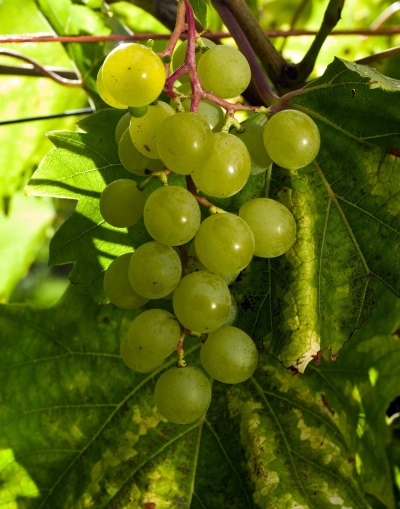
- Authors: NIIViV Bulgaria and VNIIViV them. ME AND. Potapenko, Russia. Authors I.A. Kostrikin, A.M. Aliev, B.A. Muzychenko, Jordan Ivanov, Vasil Valchev
- Appointment: universal
- Berry color: amber white
- Taste: harmonious, nutmeg
- Ripening period: early
- Frost resistance, ° C: -23
- Bunch weight, g: 221-400
- Yield: 80 c / ha
- Flower type: bisexual
- Wine tasting evaluation, points: 8,6
The fruitful cooperation of Russian and Bulgarian scientists has resulted in the Druzhba grape variety. It is unpretentious, has excellent disease resistance and is prized for its unique taste.
Breeding history
The work on the breeding of the described variety proceeded under the control of two research institutes:
- NIIViVa Bulgaria;
- VNIIViV them. Ya.I. Potapenko.
Among the authors of the bred variety:
- I. A. Kostrikin;
- A. M. Aliev;
- B. A. Muzychenko;
- Jordan Ivanov;
- Vasil Valchev.
The unique qualities of Druzhba were achieved by crossing the varieties Misket Kailyshki and XII 51/23.
Geography of distribution
The described variety is perfectly adapted to all regions of our country, therefore it can be grown everywhere.
Description
It is a versatile grape with a bisexual flower type. The bushes have medium vigor. One plant accounts for 70-85% of fruitful shoots.
According to the table, the fruiting factor is 1.1.
Such grapes do not grow, they have small light green foliage, which is not much on the vine.
Ripening period
Druzhba grapes are early ripening varieties. The bunches begin to ripen already on the 115th day from the moment the buds swell.
By the end of August, gardeners are harvesting. If the berries ripen later than the specified time, it means that the formation of bunches was poorly followed, and there is an overload of the bushes with fruits.
Bunches
Each bunch exhibits a conical shape. The density of the berries is average. The weight of each bunch is from 221 to 400 grams.
Berries
Druzhba has an amazing amber-white color.
The berries contain 194 g / dm³ of sugar, while the acidity is 7.4 g / dm³.
The fruit has a thin peel, but it is very strong. The juicy pulp will make Friendship a great addition to your fruit basket.
The fruits have a rounded shape, the weight of one berry is 4 grams, and the dimensions are 22x23 mm.
If we look at the grapes through the existing filter, then they are quite large.
The wine produced from Friendship has a tasting mark of 8.6 points.
Taste
The described variety has an amazing and in its own way unique nutmeg harmonious taste.
Yield
The grape yield is 80 centners per hectare.


Growing features
Light soils are ideal for planting. Either loam or sandy soil can be used.
In a bush, the main root grows deeply into the soil, therefore, with a high location of groundwater, root rot appears.
The landing site must be on a sunny and calm side, away from trees and tall buildings.
Landing
Druzhba grape cuttings take root well in trenches or holes. In the south of the country, planting is carried out in the fall.
If you plan to plant the territory in the central part, then it is better to do it in the spring. Before the onset of cold weather, the seedlings will be able not only to take root, but also to prepare for the cold weather.
The landing pit is prepared in advance. Organic fertilizers are placed on its bottom and everything is covered with fertile soil.
If foliage has already appeared on the seedling, then it is planted only after the threat of night frosts disappears. As a rule, this is the end of April. Cuttings without foliage can be planted in the ground from March.

Pollination
Since bisexual flowers appear on the bush, it is not required to additionally pollinate the variety.
Pruning
Pruning is necessary, 6-8 eyes are left on the vine. But up to 3 years of age, only sanitary pruning is carried out. After this period, the load on one bush should be no more than 35 eyes.
Frozen vine and heavily damaged vine must be removed. Such shoots are cut in the spring.

Watering
It is worth watering the cuttings immediately after planting and then with the beginning of the growing season once every two weeks. With the appearance of ovaries, the amount of water is halved.
The last watering is done a month before picking berries.


Top dressing
Grape bushes need to be fed at least three times per season. Bird droppings are ideal for spring. It is preliminarily dissolved in water.
The procedure is repeated two weeks later, you can use superphosphate.
Nitroammofosk is necessary during the period when ovaries are formed on the bush.
Frost resistance and the need for shelter
Friendship is able to withstand temperatures down to -23 ° C. Such frost resistance is at a high level.
If grapes are grown in northern regions, they must be covered. In the south of our country, it is enough just to huddle the bushes for the winter or use partial shelter.

Diseases and pests
Friendship is resistant to mildew, but susceptible to root and leaf phylloxera. In the absence of any treatment, it can get sick with gray rot or powdery mildew.
Processing is carried out at least once a season. It is best to use Bordeaux liquid.

If a grape is exposed to any disease or insect, this always affects its appearance.
Storage
At home, from the described variety, you can cook and roll compotes, juice. On an industrial scale, the variety is actively used for the production of high-quality wine.











































































